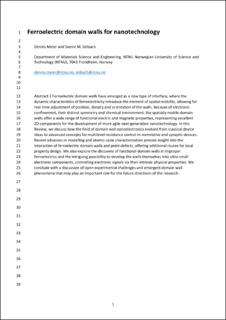| dc.contributor.author | Meier, Dennis Gerhard | |
| dc.contributor.author | Selbach, Sverre Magnus | |
| dc.date.accessioned | 2022-03-25T07:57:26Z | |
| dc.date.available | 2022-03-25T07:57:26Z | |
| dc.date.created | 2022-01-04T14:41:59Z | |
| dc.date.issued | 2021 | |
| dc.identifier.issn | 2058-8437 | |
| dc.identifier.uri | https://hdl.handle.net/11250/2987531 | |
| dc.description.abstract | Ferroelectric domain walls have emerged as a new type of interface in which the dynamic characteristics of ferroelectricity introduce the element of spatial mobility, allowing real-time adjustment of position, density and orientation of the walls. Because of electronic confinement, and of their distinct symmetry and chemical environment, the spatially mobile domain walls offer a wide range of functional electric and magnetic properties, representing excellent 2D components for the development of more agile next-generation nanotechnology. In this Review, we discuss how the field of domain-wall nanoelectronics evolved from classical device ideas to advanced concepts for multilevel resistance control in memristive and synaptic devices. Recent advances in modelling and atomic-scale characterization provide insight into the interaction of ferroelectric domain walls and point defects, offering additional routes for local property design. We also explore the discovery of functional domain walls in improper ferroelectrics and the intriguing possibility of developing the walls themselves into ultra-small electronic components, controlling electronic signals through their intrinsic physical properties. We conclude with a discussion of open experimental challenges and newly discovered domain-wall phenomena that may play an important role in future directions of the field. | en_US |
| dc.language.iso | eng | en_US |
| dc.publisher | Nature Research | en_US |
| dc.title | Ferroelectric domain walls for nanotechnology | en_US |
| dc.type | Journal article | en_US |
| dc.description.version | acceptedVersion | en_US |
| dc.rights.holder | This is the authors' accepted manuscript to an article published by Nature. | en_US |
| dc.source.journal | Nature Reviews Materials | en_US |
| dc.identifier.doi | 10.1038/s41578-021-00375-z | |
| dc.identifier.cristin | 1974488 | |
| dc.relation.project | ERC-European Research Council: 863691 | en_US |
| dc.relation.project | Norges forskningsråd: 295864 | en_US |
| dc.relation.project | Norges forskningsråd: 262633 | en_US |
| dc.relation.project | Norges forskningsråd: 231430 | en_US |
| dc.relation.project | Norges forskningsråd: 263228 | en_US |
| cristin.ispublished | true | |
| cristin.fulltext | postprint | |
